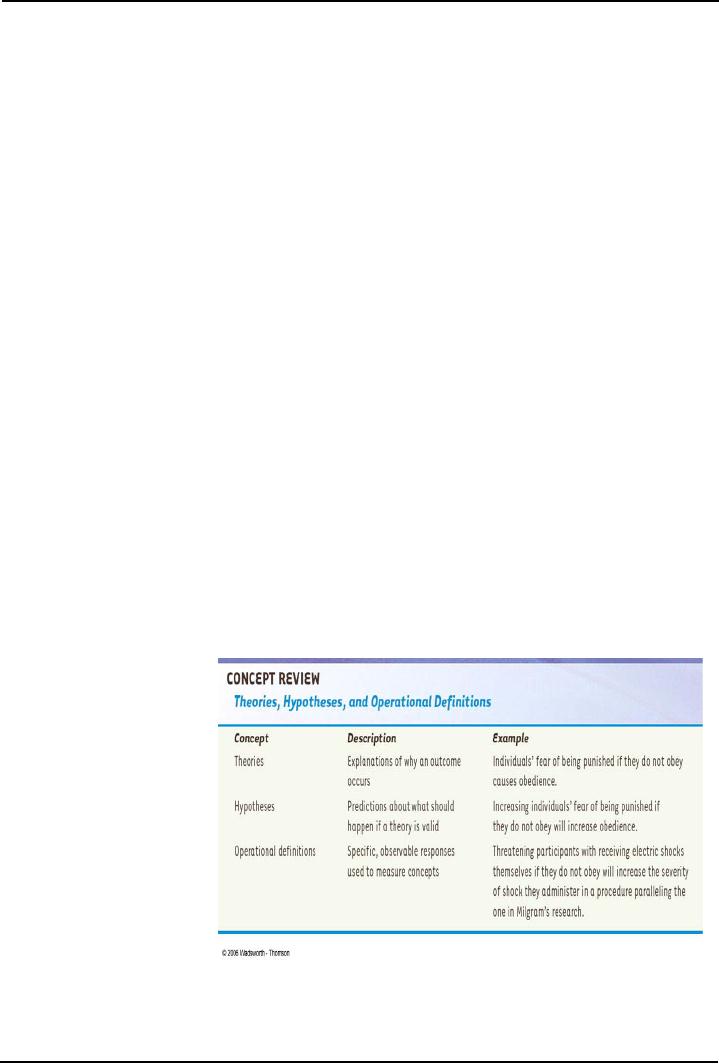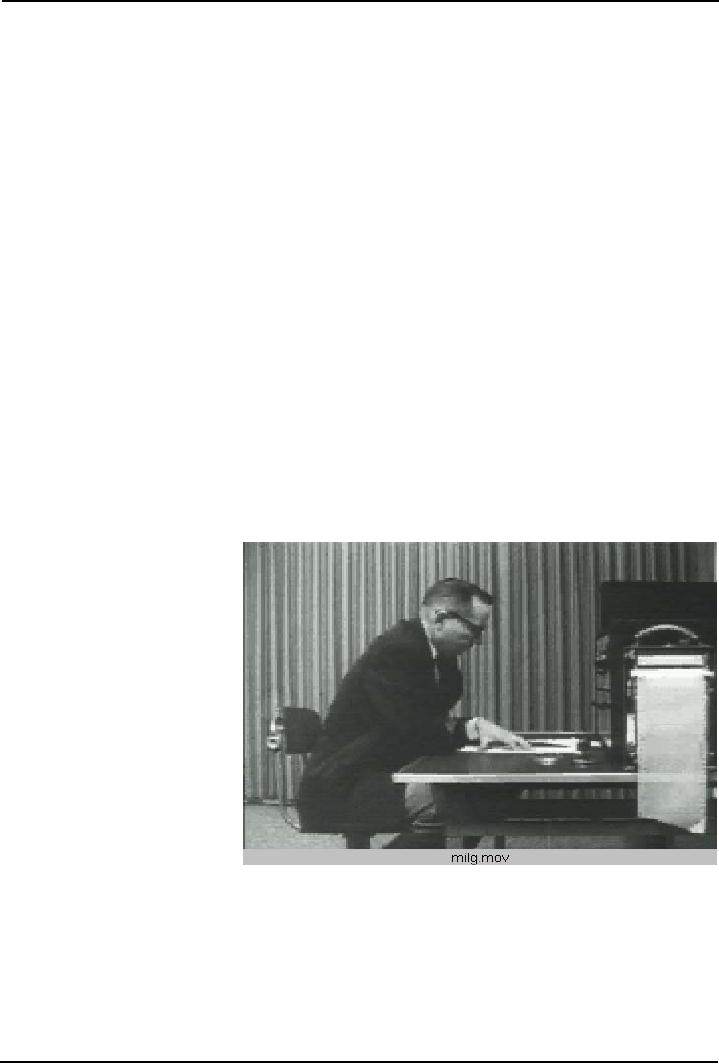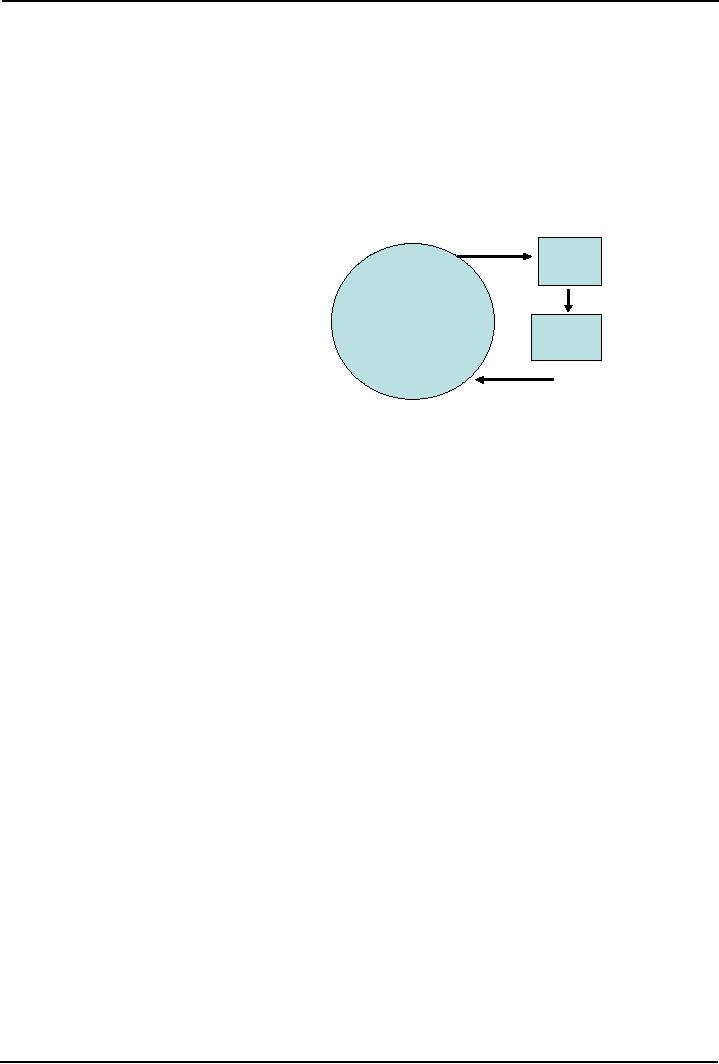 |

Social
Psychology (PSY403)
VU
Lesson
04
CONDUCTING
RESEARCH IN SOCIAL
PSYCHOLOGY:
Aims:
To
make students understand how to conduct
social psychology research using
diverse scientific
methodologies.
Objectives:
Describe
empirical research and scientific
method
Discuss
basic steps in conducting social
psychology research
RESEARCH
PROCESS
Step
1: Selection of research
question
Sternberg
(1997) indicates that some questions
are simply not worth
asking. He suggests that we
should ask
several
questions before deciding the question is
good one or not:
·
Is
my research Question a Good
One
·
Why
this question be scientifically
important?
·
What
is the scope of this question?
·
What
are the likely outcomes if I
carry out this
question?
·
Contribution
to knowledge?
·
Why
would anyone be interested in the results
obtained by asking and
answering this question?
2.
Develop a theory &
hypothesis
STEP
2: DEVELOP A THEORY AND
HYPOTHESES
The
questions of interest usually revolve
around whether some phenomenon
can be explained by a
particular
principle or theory. A theory
is
an organized system of ideas
that seeks to explain why
two or
more
events are related. What
makes a good theory depends
on a number of factors.
The
most salient factor to the
working scientist is the
predictive accuracy of the
theory: can it
reliably
predict
behavior? A second necessary
factor is internal
coherence-there should
not be any logical
inconsistencies
or unexplained coincidences among any of the
theoretical ideas. A third characteristic
of a
good
theory is that it should be
economical,
meaning
that it only contains the principles or
concepts
necessary
to explain the phenomenon in question and no more.
Finally, a fourth and very
important quality
in
a good theory is fertility
-- the ability
to fire the imagination of other
scientists so that the ideas in
the
theory
are tested and extended to a
wide variety of social
behavior.
The
way that scientists
determine the predictive accuracy of a
theory is by formulating
hypotheses.
Hypotheses
are
specific propositions or expectations
about the nature of things derived
from a theory --
they
are the logical implications of the
theory. According to Stanovich
(1988), theories that have
withstood
the
test of time have had a lot of
hypotheses confirmed.
Example:
Theory:
Exposure to a lot of TV violence is
detrimental to children's social
development
Hypothesis:
Individuals
who watch a great deal of TV violence
during childhood will be more
physically
aggressive
in adulthood than individual who watch
little TV violence
Step
3: Variables and Operational definitions
are
very precise descriptions of how the
variables have
been
quantified so that they can
be measured.
In
all scientific methods, social
psychologists seek to determine the nature of the
relationship between two
or
more factors, called variables
because
they are things that
can be measured and that can
vary. Two types
18

Social
Psychology (PSY403)
VU
of
variables are used in
hypothesis: dependent & independent
variables. When scientists
describe their
variables,
they do so by using operational
definitions.
Examples
of translating Concepts into
Operations
·
"Absence
makes the heart grow
fonder"
·
"Media
violence increases aggression"
We
need to transform our conceptual
variables into operational
variables. For example, we have to
clearly
define
what we mean by "absence" and "growing
fonder", etc.
Example
2:
Example
from Bandura's study
(1965)
Exposure
to successful aggressive models induces
aggressive behaviour in the
observer.
Hypothesis:
Children
who watch a model are either
reinforced or given no consequence
for being
aggressive
will be more likely to imitate the
model than when the model is
punished for being
aggressive.
Operational
Definitions:
Reinforcement:
the
model being given candy
and soft drinks along
with words of praise for a
superb
performance.
Punishment:
Another
adult shaking a menacing finger at the
aggressive model and saying,
"Hey, you big bully. You
quit
picking
on that clown. I won't
tolerate it."
Relationship
between concept, hypothesis, and operational
definition
Table
1 illustrates the relationship between
theory, hypothesis and operational
Relationship
between theories, hypothesis,
and
.
Step
4: Research Methods
operational
definition
After
developing a theory
and
hypotheses, researchers
must
next select a
scientific
method
that allows the
hypotheses
to be tested in a
way
that minimizes error
and
leads to dependable
generalizations.
The three
primary
scientific methods
used
by social psychologist
are
observational,
correlational,
and
experimental.
1.
Correlational
2.
Observational
3.
Experimental
Step
5: Evaluate Ethics
Conducting
research always involves a
consideration between the values of doing the
research versus the
impact
on subjects: "cost/benefit
analysis"
19

Social
Psychology (PSY403)
VU
American
Psychological Association requires the
following requirements for conducting a
research:
·
Informed
consent: voluntary participation
with full understanding of the possible
risk factors
involved
·
Anonymity:
when neither the researcher
nor the reader can identify
a given response with a
given
respondent
·
Protection
from harm: Put respondent's well-being
first
·
Confidentiality:
when the researcher can
identify a given person's response
but not to do so
publicly.
·
Minimize
deception: Deception is usually
essential in order not to
alter the respondents' responses;
Deception
cannot be used about aspects of
research that would affect
participant's willingness to
participate.
·
Debriefing:
interviewing subjects to learn
about their experience of
participation.
Communicate
results of study
Milgram's
Experiment:
Migram's
experiment published in 1963 provided a
very controversial experiment regarding
ethical
issues.
The article was entitled:
"Be
a good boy & do as u r told to
do"
In
the 1960s and 1970s, the issue of
research ethics was upper-most in the
minds of social
psychologists
because of a few controversial
studies that appeared to put
participants at risk
for
psychological
harm (Milgram, 1963; Zimbardo,
1972). The most
controversial of these studies
were
Stanley
Milgram's obedience experiments, in which
volunteers agreed to act as
teachers in a learning
experiment
that in actuality was a
study of obedience.
Although
this study and others of its
kind asked important questions
about social behavior,
serious
concerns
were raised about whether the
significance of the research topics
justified exposing participants
to
potentially
harmful psychological
consequences.
Figure
1: Research participant
working
on shock generator
·
Stanley
Milgram wanted
some
explanations for the horrors of
World War II when six
million Jews, gypsies, and
homosexuals
were slaughtered by the Nazis. He designed an
experiment to measure obedience to
know
why Germans were particularly
obedient.
·
Basic
design was to order a subject to
administer an electric shock to another
person and to see
how
far they would go with
this procedure.
·
Created
an impressive `shock generator' with 30
switches marked clearly in 15 volt
increments
from
15 to 450 volts; verbal
labels from slight shock to
danger (severe). The phoney generator
had
buzzers,
lights that flashed and
dials that moved; all
appeared authentic.
20

Social
Psychology (PSY403)
VU
·
He
found out that obedience to
authority was not a feature
of German culture but a
seemingly
universal
feature of human behaviour. He published
an article "Be a good boy
and do as you are
told"
·
This
experiment, although no shocks
given, the victim's cries were taped,
was very controversial
as
it
did not satisfy ethical
considerations of informed consent. procedure
created extraordinary
tension;
participants appeared very
stressed which showed up
with their nervous laugh,
tension, fits
of
laugh
·
Of
40 subjects all obeyed up to
300 volts, at which 5 refused and 26
continued to the end.
The
primary criticism on such experiments is
that such deception could
lead to a loss of trust in social
scientists
Analysis
of Milgram's Study
·
Diana
Baumrind's criticism regarding
psychological harms to the paticipants
(1993): She found it
difficult
to understand the similarity between Hitler's
Germnay and Milgram's lab.
Hitler's
subordinates
thought that they were doing
the great job finishing the subhumans,
while this
experiment
according to Diana had no parallel
with that situation.
Milgram's
Reply:
·
Experiment
investigated a very important
issue
·
Procedure
was defined to the subject in a way
that supported their decision to
disobey
·
Subjects
were debriefed
·
84%
were glad to participate
·
75%
indicated that they had learned something
of personal importance
·
Subjects
received a written
report
Milgram's
Conclusion
"This
experiment strengthened my belief that
man should avoid harm to his
fellow men even at the risk
of
violating
authority"
Current
Ethical Guidelines
In
1974 the U.S. government established
institutional
review boards (IRBs) for
research involving human
participants.
These reviewing bodies, which
are composed of scientists,
medical professionals, clergy,
and
other
community members, who make
sure that the welfare of human
participants is protected.
In
1982, the American Psychological
Association published guidelines
focusing on the risk/benefit
ratio.
Step
6: Collect Data
When
the IRB has granted approval, it is
time to collect data from
your sample. A sample
is
a
group
of people who are selected
to participate in a given study.
The people who are
selected to participate
in
the study come from a
population,
which
consists of all the members of an
identifiable group
from
which
a sample is drawn. The
closer a sample is in representing the
population, the greater confidence
researchers
have in generalizing their findings
beyond the sample.
Regarding
the data collected from your
sample of participants, there are
two broad categories: qualitative
and
quantitative.
Qualitative
data exists in a nonnumeric form,
such as a scientist's narrative
report of a
conversation
between two people. In contrast,
quantitative data is
numerical.
A
sample
is
a group of people who are
selected to participate in a research
study.
21

Social
Psychology (PSY403)
VU
Population
consists
of all the members of an identifiable
group from which a sample is
drawn. The people
who
are selected to participate in the
study come from a population
Population
can be events, people or
things
Figure
2: The Relationship Between
Population, Parameters, Samples &
Statistics
Some
important points about
T
h e R e la tio n s h ip B e tw e e n P o p u la tio n
,
population
and sample:
P
a r a m e te rs , S a m p le s & S ta tis
tics
1.
Population is the total number
of
subjects, events, or objects
2.
Parameters are
population
Sam
p le
characteristics
(n
=3 0 )
3.
Sample is a subset of the
population
4.
Statistics are estimates of
P
opu lation (N = 1 0 00 )
S
tatistics,
population
parameters.
e.g.,
m ean ,
5.
It is important to know the
variance
ability
to generalize from a
S
tatistics are estim ates
of
sample
to the population which
P
aram eters, e.g., tru e m
ean,
&
varian ce of p op u lation
critically
depends on the
representativeness
of the sample. Individuals in a
population differ from each
other, e.g., one
population
may have 40% males, and 60%
females, while the other could have a
ratio of 70 to 30.
A
sample is representative of the population to the
extent it exhibits the same
distribution of
characteristics
as the population.
Sampling
Strategies
Probability
samples: when
each and every element has an
equal chance of being
included
·
Simple
random: Simple Random:All items in
selected population stand an
equal chance of
inclusion
in the sample; subjects usually
chosen by random numbers
·
Systematic
random: Sample selected
according to some regular
pattern; every tenth or
so.
·
Stratified:
include quotas of population/
subgroups (strata), gender, ethnic
distribution, etc. to
ensue
an adequate sample of each.
Usually population parameters
are obtained from
census.
Representative
random sampling of all strata
must be taken.
·
Cluster:
initially a convenient group is
selected but this is then
sub sampled randomly.
Any
generalization
outside the population actually
sampled should be cautious.
·
Hybrid
or "multistage selection": Initially
based on a cluster of potential sampling
frames (several
areas,
or institutions). One of them is randomly
chosen, then individuals are
randomly chosen from
within
the chosen sampling frame (institution,
e.g.). Generalization outside actually
sampled
population
avoided.
Reference
1.
Franzoi, S.L. (2006).
Social
Psychology. New
York: McGraw Hill. Chapter
2.
22
Table of Contents:
- INTRODUCTION TO SOCIAL PSYCHOLOGY:Readings, Main Elements of Definitions
- INTRODUCTION TO SOCIAL PSYCHOLOGY:Social Psychology and Sociology
- CONDUCTING RESEARCH IN SOCIAL PSYCHOLOGY:Scientific Method
- CONDUCTING RESEARCH IN SOCIAL PSYCHOLOGY:Evaluate Ethics
- CONDUCTING RESEARCH IN SOCIAL PSYCHOLOGY RESEARCH PROCESS, DESIGNS AND METHODS (CONTINUED)
- CONDUCTING RESEARCH IN SOCIAL PSYCHOLOGY OBSERVATIONAL METHOD
- CONDUCTING RESEARCH IN SOCIAL PSYCHOLOGY CORRELATIONAL METHOD:
- CONDUCTING RESEARCH IN SOCIAL PSYCHOLOGY EXPERIMENTAL METHOD
- THE SELF:Meta Analysis, THE INTERNET, BRAIN-IMAGING TECHNIQUES
- THE SELF (CONTINUED):Development of Self awareness, SELF REGULATION
- THE SELF (CONTINUE…….):Journal Activity, POSSIBLE HISTORICAL EFFECTS
- THE SELF (CONTINUE……….):SELF-SCHEMAS, SELF-COMPLEXITY
- PERSON PERCEPTION:Impression Formation, Facial Expressions
- PERSON PERCEPTION (CONTINUE…..):GENDER SOCIALIZATION, Integrating Impressions
- PERSON PERCEPTION: WHEN PERSON PERCEPTION IS MOST CHALLENGING
- ATTRIBUTION:The locus of causality, Stability & Controllability
- ATTRIBUTION ERRORS:Biases in Attribution, Cultural differences
- SOCIAL COGNITION:We are categorizing creatures, Developing Schemas
- SOCIAL COGNITION (CONTINUE…….):Counterfactual Thinking, Confirmation bias
- ATTITUDES:Affective component, Behavioral component, Cognitive component
- ATTITUDE FORMATION:Classical conditioning, Subliminal conditioning
- ATTITUDE AND BEHAVIOR:Theory of planned behavior, Attitude strength
- ATTITUDE CHANGE:Factors affecting dissonance, Likeability
- ATTITUDE CHANGE (CONTINUE……….):Attitudinal Inoculation, Audience Variables
- PREJUDICE AND DISCRIMINATION:Activity on Cognitive Dissonance, Categorization
- PREJUDICE AND DISCRIMINATION (CONTINUE……….):Religion, Stereotype threat
- REDUCING PREJUDICE AND DISCRIMINATION:The contact hypothesis
- INTERPERSONAL ATTRACTION:Reasons for affiliation, Theory of Social exchange
- INTERPERSONAL ATTRACTION (CONTINUE……..):Physical attractiveness
- INTIMATE RELATIONSHIPS:Applied Social Psychology Lab
- SOCIAL INFLUENCE:Attachment styles & Friendship, SOCIAL INTERACTIONS
- SOCIAL INFLUENCE (CONTINE………):Normative influence, Informational influence
- SOCIAL INFLUENCE (CONTINUE……):Crimes of Obedience, Predictions
- AGGRESSION:Identifying Aggression, Instrumental aggression
- AGGRESSION (CONTINUE……):The Cognitive-Neo-associationist Model
- REDUCING AGGRESSION:Punishment, Incompatible response strategy
- PROSOCIAL BEHAVIOR:Types of Helping, Reciprocal helping, Norm of responsibility
- PROSOCIAL BEHAVIOR (CONTINUE………):Bystander Intervention, Diffusion of responsibility
- GROUP BEHAVIOR:Applied Social Psychology Lab, Basic Features of Groups
- GROUP BEHAVIOR (CONTINUE…………):Social Loafing, Deindividuation
- up Decision GROUP BEHAVIOR (CONTINUE……….):GroProcess, Group Polarization
- INTERPERSONAL POWER: LEADERSHIP, The Situational Perspective, Information power
- SOCIAL PSYCHOLOGY APPLIED: SOCIAL PSYCHOLOGY IN COURT
- SOCIAL PSYCHOLOGY APPLIED: SOCIAL PSYCHOLOGY IN CLINIC
- FINAL REVIEW:Social Psychology and related fields, History, Social cognition